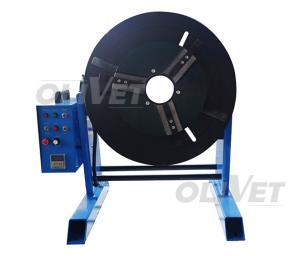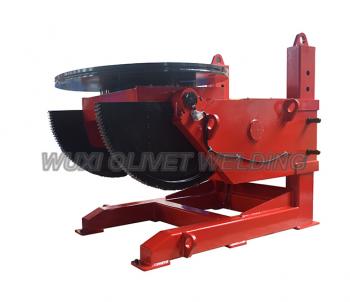
E-mail:sales@chinaolivet.cn


An appropriately positioned weldment permits welders to work in a comfortable placement at all times, decreasing fatigue as well as raising general safety and security.
It is a widely known truth that weld positioners can assist welders in handling and welding large assemblies. What could not be so well-known is that several small assemblies likewise can be mechanically positioned to provide the welder with the very same advantages.
The concepts of positioning coincide for all weldments, huge or little. The base product is attached to the placing tools and then steered by mechanical ways right into a setting that enables one of the most effective weldings and setting up. As components or subassemblies are added, the entire weldment is transferred to allow very easy access to weld joints.
A correctly positioned weldment, despite the dimension, lowers welder exhaustion, raises safety, boosts weld top quality, and also saves money on manufacturing floor space. By relocating the weldment making use of mechanical ways as well as placing the welding area into a comfortable range, welders are not required to weld out of placement or in an uneasy position.
Security is boosted when the weldment is secured to an appropriate positioning gadget. Cranes, chains, slings, and other non-rigid methods of moving a part could develop unchecked movement, which can be dangerous. With the help of a positioner, welders do not have to maneuver themselves beneath a potentially heavy weldment, reducing the risk of injury from dropping triggers, slag, or components.
While lots of welders are qualified to do overhead as well as vertical welding, down and welds typically need much less training, permitting brand-new welders to generate high-quality welds. Gravity assists the welder in a downhill weld, leading to equal legs on fillet welds, smoother grain surface, and minimized cleaning and also rework times.
By incorporating a China Welding Positioner with a welding source of power as well as a torch stand, a welder can perform semiautomatic welding that is efficient and ergonomically friendly. The positioner holds the part and maneuvers it under a stationary lantern. This torch can be fitted with a weaving device to enable oscillation to fill big gaps or V-grooves. Regular speed and lantern placement improve the top quality of the weld with higher repeatability. By using a communication cable between the incorporated positioner and also a welding power supply, the operator just needs to indicate a beginning with a foot pedal or a beginning switch, and the welding cycle will proceed till the signal is immediately sent out that it has actually completed. This approach, usually utilized on a circumferential weld, can include dwell times to create a pool and fill the crater. The finished part is removed and one more is started.
No matter the dimension of the weldment, welders need to keep these 5 recommendations in mind when choosing, operating, and also preserving a positioner.
Selecting the appropriate positioning tool for the task involves accountancy not just for the weight and also dimension of the weldment, yet likewise for the center of gravity (GEAR) and exactly how far it is from the placing tool. GEAR is the factor at which the weldment equilibriums on all axes just as. As the distance increases from the tool, even more torque is related to the positioner. The GEAR modifications as the welder add material and components to the positioner, so these modifications have to be considered.
The table revolves with a variable-speed electrical motor and also can be hand- or foot-controlled. The positioner motor and control ought to be picked based upon the dimension and speed that are required to carry out the wanted welding procedure.
The welding positioner manufacturer's specs will lead the electric motor and also control choice. It's important for welders to inspect the requirements for both straight and vertical loading to make certain ability is adequate to take care of the weldment. The positioner should have the ability to withstand the biggest feasible tons.

Just how a weldment is attached to a placing tool is as essential as the positioner itself, because this is the factor where separation would normally happen. Production components are created for a detailed application carried out consistently. This type of fixture is placed permanently to the positioner, and its certain form enables very easy component alignment.
Round components typically are attached by a three-jaw chuck. The component should not retreat from the jaws when the part prolongs from the table. Additionally, the part may expand or get from the heating and cooling that occur throughout as well as after the welding procedure, which can transform the hold that the chuck has on the workpiece.
Fixtures and also chucks include weight and distance from the faceplate, which requires to be thought about when sizing the positioning gadget. While the weight of a weldment applies torque to the tool, the distance that weight is applied multiplies the torque by the increase in distance. As an example, a 50-lb. weldment that is 3 inches far from the face of the placing table develops 12.5 ft.-lbs. of torque in the vertical setting. If the distance is increased to 6 in., the torque enhances to 25 ft.-lbs. at the installation surface. The increased torque may require a larger-capacity machine.
Many positioners have ports that permit the work surface to be bolted to the face. Bonding the part to the positioner is frequently a great way to prevent shear forces from moving the part as it is navigated. Any of these methods, whether stand-alone or mixed, will certainly function if used appropriately.
If a weldment is cylindrical, it is eligible to be rolled. Tiny transforming rolls-- powered or idler type-- can rotate a pipeline or vessel to make it possible for down hand welds. The power rolls provide consistent turning, generating an even circumferential weld. Idler rolls are not powered yet can be added in the collection to sustain longer pipes and also vessels. Commonly these are utilized for including flanges to pipe ends as well as connecting pipelines and also finishes to vessels.
The mix of a roller-type pipe stand and also a vertical-faced table positioner supplies stability and also safety when a rounded part is expanded outside. When the rollers give two factors of getting in touch with, the weight is distributed evenly, and also the COG can be sustained.
Despite tiny placing devices, it is necessary that the device is installed to a level, even surface area to prevent it from tipping. If installing openings are supplied, they must be made use of to safeguard the positioner to a steady surface area to avoid tipping when or if it runs into an unexpected force. A positioner installed to a workbench or stand needs to be safeguarded too.
Throughout welding, a ground current must be attached to the positioner itself. The ground current transfers from the table and right into the framework, which removes having to remove and also change a welding clamp continuously. Without correct grounding, electrical components can be damaged and also substandard weld deposits made.
The positioner needs to be compatible with the electric present generated by the welding process. Also, all ground cords should be protected tightly by removing any type of paint before bolting to the carriage.
Previous: How Does Welding Manipulator Work?
Wuxi OLIVET Machinery Equipment Co.,LTD.E-mail: sales@chinaolivet.cnTel: +86-510-8383 0908
Home About UsProductsQuality ControlCompany NewsContact Us Sitemap
Copyright©2015 Wuxi OLIVET Machinery Equipment Co.,Ltd. Technical Support: Reanod